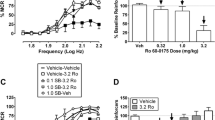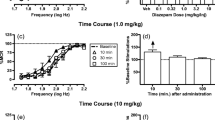Abstract
3,4-Methylenedioxymethamphetamine (MDMA) is a psychoactive phenylisopropylamine which is structurally similar to both amphetamine-related sympathomimetics and the hallucinogen, mescaline. MDMA produces pleasurable effects which include euphoria, and recent reports continue to demonstrate its widespread recreational use. The aim of the present study was to assess the effects of racemic MDMA on the threshold for rewarding intracranial self-stimulation, an animal model used to assess a drug's abuse liability in man. Rewarding electrical stimulation was delivered via electrodes stereotaxically implanted in the medial forebrain bundle-lateral hypothalamic area of the rat brain. Thresholds were determined by means of a rate-independent psychophysical method. MDMA produced a dose-related lowering of the reward threshold in all four animals tested. Given that increased sensitivity for rewarding brain stimulation, measured as a lowering of the reward threshold, is an animal model of drug-induced euphoria these results suggest a similar mode of action for its reinforcing effects as other abused substances.
Similar content being viewed by others
References
Anderson GM, Braun G, Braun U, Nichols DE, Shulgin AT (1978) Absolute configuration and psychotomimetic activity. NIDA Research Monograph 22:8–15
Esposito R, Kornetsky (1977) Morphine lowering of self-stimulation thresholds: lack of tolerance with long-term administration. Science 195:189–191
Glennon RA, Young R (1984) Further investigation of the discriminative stimulus properties of MDA. Pharmacol Biochem Behav 20:501–505
Glennon RA, Young R, Rosecrans JA, Anderson GM (1982) Discriminative stimulus properties of MDA analogs. Biol Psychiatry 17:807–814
Goldstein A (1964) Biostatistics: An introductory text. Macmillian, New York, pp 203–267
Greer G (1983) MDMA: a new psychotropic compound and its effects in humans. [personal publication] pp 1–15
Greer G, Strassman RJ (1985) Information on “ecstasy”. Am J Psychiatry 142:11
Kornetsky C (1985) Brain stimulation reward: a model for drug-induced euphoria. NIDA Monograph Series 62:30–49
Kornetsky C, Esposito RU, McLean S, Jacobson JO (1979) Intracranial self-stimulation thresholds: a model for the hedonic effects of drugs of abuse. Arch Gen Psychiatry 36:289–292
Lyon RA, Glennon RA, Titeler M (1986) 3,4-Methylenedioxymethamphetamine (MDMA): stereoselective interactions at brain 5-HT1 and 5-HT2 receptors. Psychopharmacology 88:525–526
Ricarte GA, Forno LS, Wilson MA, DeLaney LE, Irwin I, Molliver ME, Langston JW (1987) Methylenedioxymethamphetamine (MDMA) exerts toxic effects on control serotonergic neurons in primates. Soc Neurosci Abstr 13(2):905
Schechter MD (1986) Discriminative profile of MDMA. Pharmacol Biochem Behav 24:1533–1537
Shulgin AT, Nichols DE (1978) Characterization of three new psychotomimetics. In: Stillman RC, Willette RE (eds) The psychopharmacology of hallucinogens. Pergamon Press, New York, pp 74–83
Author information
Authors and Affiliations
Rights and permissions
About this article
Cite this article
Hubner, C.B., Bird, M., Rassnick, S. et al. The threshold lowering effects of MDMA (ecstasy) on brain-stimulation reward. Psychopharmacology 95, 49–51 (1988). https://doi.org/10.1007/BF00212765
Received:
Revised:
Issue Date:
DOI: https://doi.org/10.1007/BF00212765




